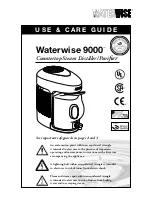
Maintenance
54
RT-SVX22M-EN
Microchannel (MCHE) Coils
Due to the soft material and thin walls of the MCHE coils,
the traditional field maintenance method recommended
for Round Tube Plate Fin (RTPF) coils does not apply to
microchannel coils.
Moreover, chemical cleaners are a risk factor to MCHE due
to the material of the coil. The manufacturer does not
recommend the use of chemical cleaners to clean
microchannel coils. Using chemical cleaners could lead to
warranty claims being further evaluated for validity and
failure analysis.
The recommended cleaning method for microchannel
condenser coils is pressurized water or air with a non-
pinpoint nozzle and an ECU of at least 180 with pressure no
greater than 600 psi.To minimize the risk of coil damage,
approach the cleaning of the coil with the pressure washer
aimed perpendicular to the face of the coil.
Note:
For more details on Microchannel coil cleaning,
please refer to bulletin RT-SVB83*-EN.
Round Tube Plate Fin (RTPF) Coils
1.
Remove enough panels from the unit to gain access to
the coil.
2. Protect all electrical devices such as motors and
controllers from any over spray.
3. Straighten any bent coil fins with a fin comb.
4. Mix the detergent with water according to the
manufacturer’s instructions. If desired, heat the
solution BUT DO NOT EXCEED 150ºF maximum to
improve its cleansing capability.
5. Pour the cleaning solution into the sprayer. If a high-
pressure sprayer is used:
a. do not allow sprayer pressure to exceed 600 psi.
b. the minimum nozzle spray angle is 15 degrees.
c. maintain a minimum clearance of 6" between the
sprayer nozzle and the coil.
d. spray the solution perpendicular (at 90 degrees) to
the coil face.
6. Spray the leaving-airflow side of the coil first; then
spray the opposite side of the coil. Allow the cleaning
solution to stand on the coil for five minutes.
7.
Rinse both sides of the coil with cool, clean water.
8. Inspect both sides of the coil; if it still appears to be
dirty, repeat Steps 6 and 7.
9. Reinstall all of the components and panels removed in
Step 1 and any protective covers installed in step 2.
Note:
For units equipped with hail guards follow
reinstallation procedure listed below.
Hail Guard Reinstallation
10. To reinstall the hail guard, locate the bottom of the hail
guard in the lower bracket and secure it to the upper
unit bracket with the attached fasteners.
Note:
Secure hail guard latches.
11. Restore the unit to its operational status and check
system operation.
NOTICE:
Coil Damage!
DO NOT use any detergents with microchannel
condenser coils. Use pressurized water or air ONLY,
with pressure no greater than 600psi. Failure to do so
could result in coil damage.
For additional information regarding the proper
microchannel coil cleaning procedure, refer to RT-
SVB83*-EN.
WARNING
Hazardous Chemicals!
Coil cleaning agents can be either acidic or highly
alkaline and can burn severely if contact with skin
occurs. Handle chemical carefully and avoid contact
with skin. ALWAYS wear Personal Protective Equipment
(PPE) including goggles or face shield, chemical
resistant gloves, boots, apron or suit as required. For
personal safety refer to the cleaning agent
manufacturer’s Materials Safety Data Sheet and follow
all recommended safe handling practices. Failure to
follow all safety instructions could result in death or
serious injury.
WARNING
Hazardous Pressures!
Coils contain refrigerant under pressure. When cleaning
coils, maintain coil cleaning solution temperature under
150°F to avoid excessive pressure in the coil. Failure to
follow these safety precautions could result in coil
bursting, which could result in death or serious injury.
Figure 55.
Hail guard
Содержание TSC037E
Страница 38: ...Installation 38 RT SVX22M EN Figure 51 Examples...
Страница 66: ......
Страница 67: ......















































